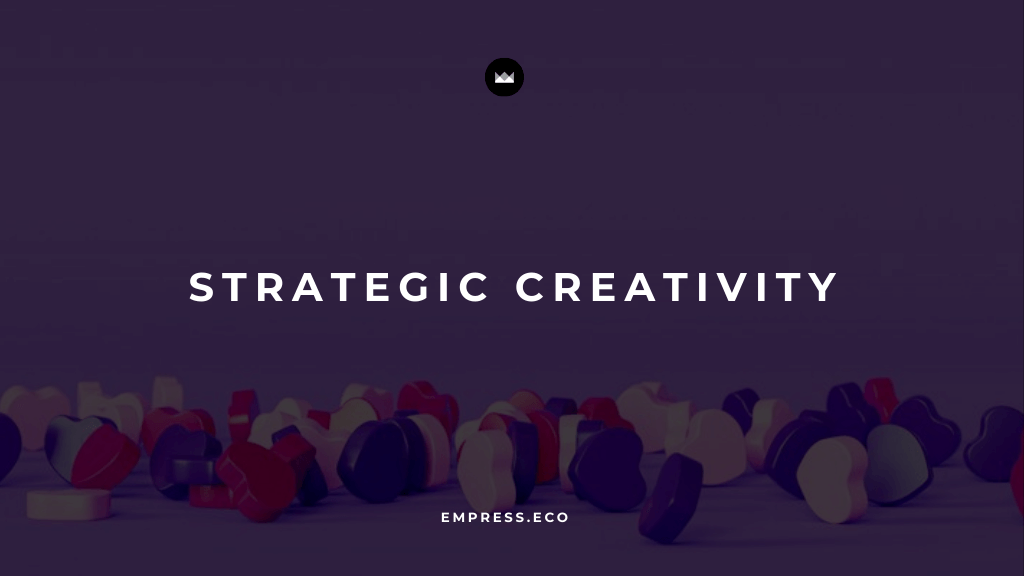
Strategic Creativity: Aligning Design with Business Goals for Maximum Impact
Techniques to enhance your brand’s aura and foster lasting customer engagement.
Table of Contents
In today's competitive business landscape, aligning creativity with strategic objectives is essential for achieving sustainable growth and maximum impact. Strategic creativity involves integrating innovative design with business goals to create compelling and effective solutions that resonate with your target audience. This blog explores the importance of strategic creativity and provides actionable steps to align design with business goals for maximum impact.
Understanding Strategic Creativity
Strategic creativity is the process of combining creative thinking with strategic planning to achieve business objectives. It involves developing a clear vision, setting goals, and creating a roadmap that guides the design process from concept to execution. This approach ensures that creative efforts are aligned with the broader strategic vision of the organization.
Benefits of Aligning Design with Business Goals
Enhanced Brand Identity
Aligning design with business goals helps create a cohesive and consistent brand identity. This consistency reinforces brand recognition and trust, making it easier for customers to connect with your brand.
Improved Customer Engagement
Strategic creativity ensures that design efforts are focused on meeting customer needs and preferences. By creating user-centric designs, businesses can enhance customer engagement and satisfaction.
Increased Competitive Advantage
A well-defined design strategy sets your brand apart from competitors. By leveraging innovative design solutions that align with business goals, you can create unique value propositions that attract and retain customers.
Better Resource Allocation
Aligning design with business goals ensures that resources are used efficiently. By focusing on high-impact design projects that contribute to strategic objectives, businesses can optimize their resource allocation and achieve better results.
Key Strategies for Aligning Design with Business Goals
Set Clear Objectives
Define specific, measurable, achievable, relevant, and time-bound (SMART) goals for your design strategy. These objectives should align with your overall business goals and provide a clear direction for your design efforts.
Examples of Objectives:
- Increase website traffic by 30% in six months.
- Boost social media engagement by 25% in three months.
- Generate 100 new leads per month through design-driven marketing campaigns.
Understand Your Audience
Conduct thorough research to understand your target audience’s demographics, preferences, and behaviors. Creating detailed buyer personas can help tailor your design to meet their needs and interests.
Steps to Understand Your Audience:
- Surveys and Interviews: Gather direct feedback from your audience.
- Analytics: Use tools like Google Analytics and social media insights.
- Competitor Analysis: Study your competitors’ strategies to identify gaps and opportunities.
Develop a Comprehensive Design Strategy
A comprehensive design strategy outlines how you plan to achieve your design objectives. It should include a clear vision, design principles, and a roadmap for execution.
Elements of a Design Strategy:
- Vision: Define the long-term vision for your design efforts.
- Design Principles: Establish guiding principles that reflect your brand values and goals.
- Roadmap: Create a detailed plan that outlines the steps needed to achieve your design objectives.
Foster Collaboration and Innovation
Encourage collaboration across teams and departments to integrate diverse perspectives and expertise. Creating an environment that supports experimentation and learning from failures is crucial for fostering innovation.
Collaboration Tips:
- Cross-Functional Teams: Form teams with members from different departments to bring varied perspectives.
- Brainstorming Sessions: Host regular brainstorming sessions to generate new ideas.
- Open Communication: Promote open communication to ensure that everyone has a voice.
Utilize Data-Driven Insights
Leverage data to inform your design decisions. Analyzing data on customer behavior, market trends, and design performance can provide valuable insights that guide your design strategy.
Data-Driven Design Tips:
- User Testing: Conduct user testing to gather feedback on design prototypes.
- A/B Testing: Use A/B testing to compare different design variations and determine what works best.
- Analytics Tools: Utilize analytics tools to track design performance and identify areas for improvement.
Overcoming Challenges in Aligning Design with Business Goals
Balancing Creativity and Strategy
While creativity is essential, it must be balanced with strategic objectives. Ensure that creative efforts are aligned with business goals and contribute to measurable outcomes.
Ensuring Flexibility and Adaptability
The business environment is constantly changing, and design strategies must be flexible and adaptable. Regularly review and adjust your design strategy to respond to new trends and market dynamics.
Measuring Impact and ROI
Evaluating the success of design efforts requires clear metrics and objectives. Track key performance indicators (KPIs) such as engagement, conversion rates, and customer feedback to assess the impact and refine your strategy.
Case Studies: Successful Alignment of Design and Business Goals
Apple’s Design-Driven Innovation
Apple’s success is largely attributed to its strategic alignment of design and business goals. By focusing on user-centric design and innovative products, Apple has created a strong brand identity and sustained competitive advantage.
Key Takeaways from Apple’s Strategy:
- User-Centric Design: Apple prioritizes user experience in every product design, ensuring that functionality and aesthetics are seamlessly integrated.
- Consistent Branding: Apple maintains a consistent brand identity across all touchpoints, reinforcing brand recognition and loyalty.
- Innovation Culture: Apple fosters a culture of innovation, encouraging employees to experiment and push the boundaries of design and technology.
Airbnb’s User-Centric Design Strategy
Airbnb’s design strategy focuses on creating seamless and engaging user experiences. By aligning design efforts with business goals, Airbnb has enhanced customer satisfaction and driven significant growth.
Key Takeaways from Airbnb’s Strategy:
- Customer Feedback: Airbnb continuously collects and analyzes customer feedback to improve their platform and services.
- Personalization: Airbnb uses data to personalize user experiences, making it easier for customers to find accommodations that meet their needs.
- Community Engagement: Airbnb fosters a sense of community among hosts and guests, creating a unique and engaging brand experience.
Implementing Strategic Creativity in Your Business
To successfully align design with business goals, consider the following steps:
- Conduct a Design Audit: Review your current design efforts to identify strengths, weaknesses, and opportunities for improvement. Assess how well your design aligns with your business goals and customer needs.
- Develop a Design Vision: Define a clear vision for your design efforts that aligns with your overall business strategy. This vision should reflect your brand values and serve as a guiding principle for all design initiatives.
- Set SMART Goals: Establish specific, measurable, achievable, relevant, and time-bound (SMART) goals for your design strategy. These goals should provide a clear direction and help measure the success of your design efforts.
- Create a Comprehensive Design Strategy: Develop a detailed plan that outlines your design objectives, principles, and roadmap. Ensure that your strategy is flexible and adaptable to respond to changing market dynamics.
- Foster a Collaborative Culture: Encourage collaboration across teams and departments to integrate diverse perspectives and expertise. Promote open communication and create an environment that supports experimentation and learning from failures.
- Leverage Data-Driven Insights: Use data to inform your design decisions. Analyze customer behavior, market trends, and design performance to guide your strategy and identify areas for improvement.
- Regularly Review and Adjust: Continuously monitor and assess the performance of your design efforts. Use feedback and data insights to refine your strategy and ensure that it remains aligned with your business goals.
Conclusion
Strategic creativity is essential for aligning design with business goals and achieving maximum impact. By setting clear objectives, understanding your audience, developing a comprehensive design strategy, fostering collaboration, and utilizing data-driven insights, businesses can create compelling and effective design solutions that drive success.
As the business landscape continues to evolve, embracing strategic creativity will be crucial for maintaining a competitive edge and achieving sustainable growth. Start aligning your design efforts with your business goals today to unlock new levels of innovation and impact.
Empress Newsletter
Join the newsletter to receive the latest updates in your inbox.



